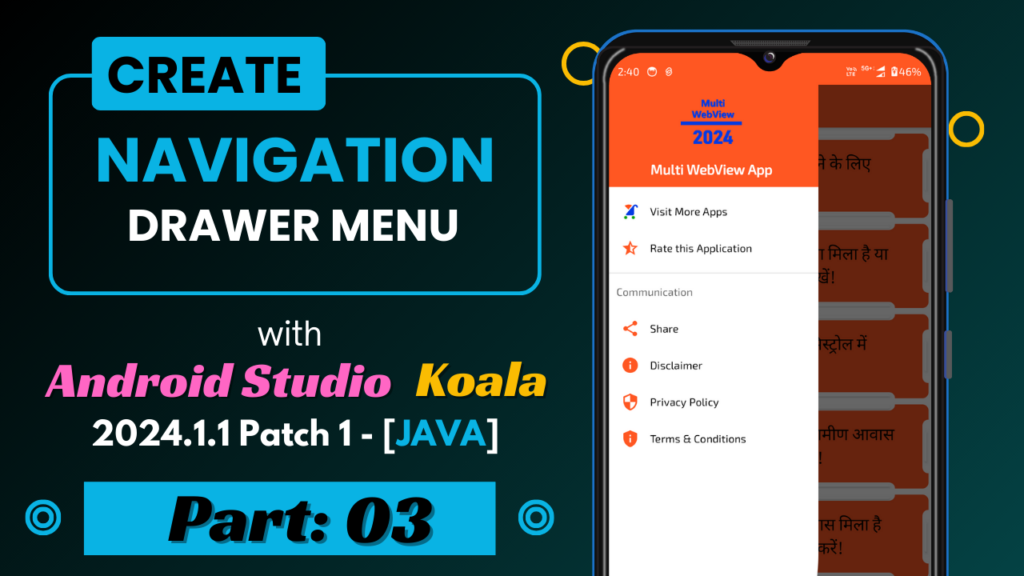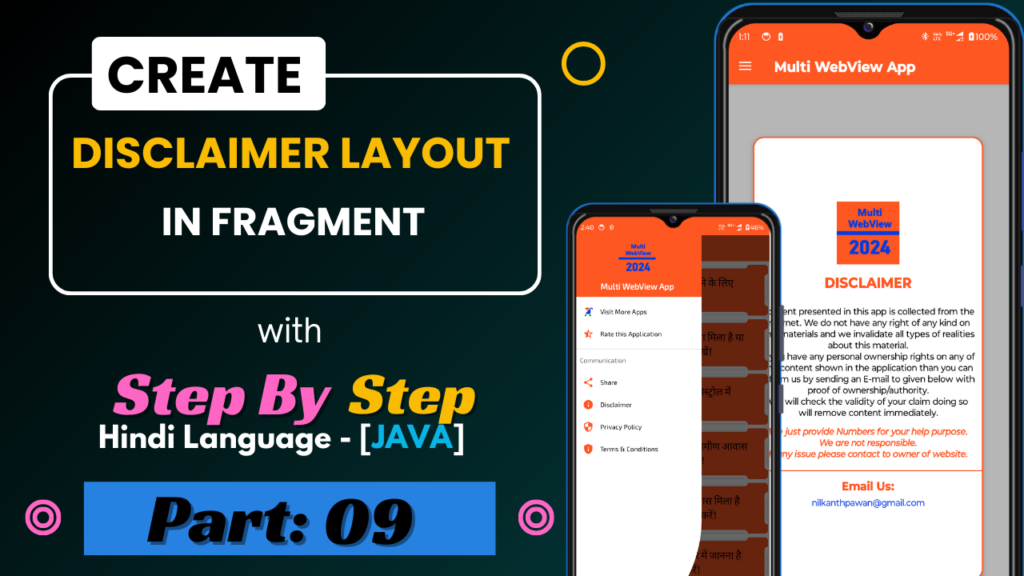In this blog, we create a navigation drawer menu for a multi-webview app with the latest Android Studio [IDE]. And also we have to implement all code for the navigation drawer layout.
For a better understanding, you have to Watch a YouTube video.
NOTE: Use IDE Version:- [Android Studio Koala | 2024.1.1 Patch 1] Or Above !
Step: 01
First, we must create a navigation header layout with the codes below.
android:layout_height="176dp"
android:background="@color/purple_200"
android:fitsSystemWindows="true"
android:gravity="center"
android:orientation="vertical"
<ImageView
android:layout_width="80dp"
android:layout_height="80dp"
android:contentDescription="@string/app_name"
android:elevation="4dp"
android:src="@drawable/logo" />
<TextView
android:id="@+id/header_title"
android:layout_width="match_parent"
android:layout_height="wrap_content"
android:layout_marginTop="8dp"
android:gravity="center_horizontal"
android:text="@string/custom_app_name"
android:textAppearance="@style/TextAppearance.AppCompat.Medium"
android:textColor="@color/white"
android:textStyle="bold" />
Step: 02
Now create a navigation menu items icon that shows in the navigation drawer. The menu items are given below.
Get all the menu items icon file
Step: 03
Now, create navigation drawer menu items which are given below.
<?xml version="1.0" encoding="utf-8"?>
<menu xmlns:android="http://schemas.android.com/apk/res/android">
<group android:checkableBehavior="single">
<item
android:id="@+id/nav_more_apps"
android:icon="@drawable/ic_nav_menu_more_apps"
android:title="@string/more_apps" />
<item
android:id="@+id/nav_rate_this_app"
android:icon="@drawable/ic_nav_menu_star_half"
android:title="@string/rate_this_app" />
</group>
<item android:title="@string/communication">
<menu>
<item
android:id="@+id/nav_share"
android:icon="@drawable/ic_nav_share"
android:title="@string/share" />
<item
android:id="@+id/nav_disclaimer"
android:icon="@drawable/ic_nav_menu_info"
android:title="@string/disclaimer" />
<item
android:id="@+id/nav_privacy_policy"
android:icon="@drawable/ic_nav_menu_security"
android:title="@string/privacy_policy" />
<item
android:id="@+id/nav_terms_conditions"
android:icon="@drawable/ic_nav_menu_privacy_tip"
android:title="@string/terms_conditions" />
</menu>
</item>
</menu>
::: XML Layout Code Below :::
Step: 04
Now, we move the “activity_home.xml” layout and we create all layout step by step.
Create a Drawer Layout:
<?xml version="1.0" encoding="utf-8"?>
<androidx.drawerlayout.widget.DrawerLayout xmlns:android="http://schemas.android.com/apk/res/android"
xmlns:app="http://schemas.android.com/apk/res-auto"
xmlns:tools="http://schemas.android.com/tools"
android:id="@+id/drawerLayout"
android:layout_width="match_parent"
android:layout_height="match_parent"
android:background="@color/white"
android:fitsSystemWindows="true"
tools:context=".HomeActivity">
</androidx.drawerlayout.widget.DrawerLayout>
Create a CoordinatorLayout:
<androidx.coordinatorlayout.widget.CoordinatorLayout
android:layout_width="match_parent"
android:layout_height="match_parent">
</androidx.coordinatorlayout.widget.CoordinatorLayout>
Create an AppBar Layout:
<com.google.android.material.appbar.AppBarLayout
android:id="@+id/appBarLayout"
android:layout_width="match_parent"
android:layout_height="wrap_content"
android:theme="@style/ThemeOverlay.AppCompat.Dark.ActionBar">
</com.google.android.material.appbar.AppBarLayout>
Create a ToolBar Layout:
<androidx.appcompat.widget.Toolbar
android:id="@+id/toolBar"
android:layout_width="match_parent"
android:layout_height="?attr/actionBarSize"
android:theme="@style/ThemeOverlay.AppCompat.Dark.ActionBar">
</androidx.appcompat.widget.Toolbar>
Create a Constraint Layout:
<androidx.constraintlayout.widget.ConstraintLayout
android:layout_width="match_parent"
android:layout_height="match_parent">
</androidx.constraintlayout.widget.ConstraintLayout>
Create a TextView Layout:
<TextView
android:id="@+id/textView"
android:layout_width="0dp"
android:layout_height="wrap_content"
android:text="@string/custom_app_name"
android:textAppearance="@style/TextAppearance.AppCompat.Large"
android:textStyle="bold"
app:layout_constraintBottom_toBottomOf="parent"
app:layout_constraintEnd_toEndOf="parent"
app:layout_constraintStart_toStartOf="parent"
app:layout_constraintTop_toTopOf="parent" />
Create a Navigation View Layout:
<com.google.android.material.navigation.NavigationView
android:id="@+id/navigationMenu"
android:layout_width="wrap_content"
android:layout_height="match_parent"
android:layout_gravity="start"
android:scrollbars="vertical"
app:menu="@menu/navigation_menu" />
::: Java Codes Implemented Below :::
Step: 05
Now, go to the “HomeActivity.java” file and import the connect navigation drawer menu codes.
First, We Import Variable:
ActionBarDrawerToggle actionBarDrawerToggle;
View view;
private DrawerLayout drawerLayout;
Second, We Import ToolBar:
Toolbar toolbar = findViewById(R.id.toolBar);
setSupportActionBar(toolbar);
Objects.requireNonNull(getSupportActionBar()).setTitle(null);
getSupportActionBar().setDisplayHomeAsUpEnabled(true);
Third, Import Drawer Layout:
drawerLayout = findViewById(R.id.drawerLayout);
actionBarDrawerToggle = new ActionBarDrawerToggle(HomeActivity.this, drawerLayout, R.string.drawer_open, R.string.drawer_close);
actionBarDrawerToggle.getDrawerArrowDrawable().setColor(getResources().getColor(R.color.white));
drawerLayout.addDrawerListener(actionBarDrawerToggle);
actionBarDrawerToggle.syncState();
Fourth, Create Navigation View:
NavigationView navigationView = findViewById(R.id.navigationMenu);
view = navigationView.inflateHeaderView(R.layout.navigation_header);
navigationView.setItemIconTintList(null);
Fifth, Create a set navigation Item Selected Listener:
navigationView.setNavigationItemSelectedListener(item -> {
UserMenuSelector(item);
return false;
});
Sixth, Import on option item selected method:
@Override
public boolean onOptionsItemSelected(@NonNull MenuItem item) {
int id = item.getItemId();
if (actionBarDrawerToggle.onOptionsItemSelected(item))
return true;
return super.onOptionsItemSelected(item);
}
Seventh, Import on user menu selector method chosen:
private void UserMenuSelector(MenuItem item) {
int itemID = item.getItemId();
if (itemID == R.id.nav_more_apps) {
try {
Intent intent = new Intent(Intent.ACTION_VIEW, Uri.parse(getString(R.string.DeveloperApp)));
startActivity(intent);
} catch (Exception ex) {
Intent intent = new Intent(Intent.ACTION_VIEW, Uri.parse(getString(R.string.developerApps)));
startActivity(intent);
}
} else if (itemID == R.id.nav_rate_this_app) {
try {
startActivity(new Intent(Intent.ACTION_VIEW, Uri.parse("market://details?id=" + getPackageName())));
} catch (ActivityNotFoundException e) {
startActivity(new Intent(Intent.ACTION_VIEW, Uri.parse("http://play.google.com/store/apps/details?id=" + getPackageName())));
}
} else if (itemID == R.id.nav_share) {
Intent myIntent = new Intent(Intent.ACTION_SEND);
myIntent.setType(getString(R.string.text_plain));
String shareBody = getString(R.string.AppDescription) + getString(R.string.AppLink);
String shareSub = getString(R.string.sub_here);
myIntent.putExtra(Intent.EXTRA_SUBJECT, shareSub);
myIntent.putExtra(Intent.EXTRA_TEXT, shareBody);
startActivity(Intent.createChooser(myIntent, getString(R.string.shareUsing)));
} else if (itemID == R.id.nav_disclaimer) {
} else if (itemID == R.id.nav_privacy_policy) {
} else if (itemID == R.id.nav_terms_conditions) {
}
drawerLayout.closeDrawer(GravityCompat.START);
}
< :::::::::: Thank You :::::::::: >

![Splash Screen for Multi Webview App. || Part – 01 || with [ Java Language ].](https://click2code.com/wp-content/uploads/2024/07/Black-and-Yellow-Modern-Trading-Tutorial-YouTube-Thumbnail-1024x576.png)
![How to create a recycler view in fragment layout in Android Studio? | Part – 05[A] and 05[B] | Multi Webview App Tutorial](https://click2code.com/wp-content/uploads/2024/08/Black-and-Yellow-Modern-Trading-Tutorial-YouTube-Thumbnail-1-1024x576.png)

